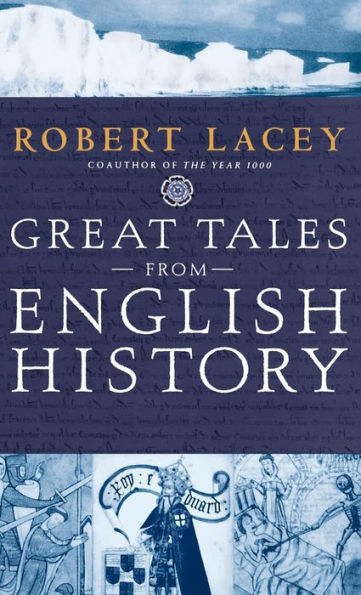
Great Tales from English History: The Truth about King Arthur, Lady Godiva, Richard the Lionheart, and More
272
Great Tales from English History: The Truth about King Arthur, Lady Godiva, Richard the Lionheart, and More
272Hardcover
-
PICK UP IN STORECheck Availability at Nearby Stores
Available within 2 business hours
Related collections and offers
Overview
The greatest historians are vivid storytellers, Robert Lacey reminds us, and in Great Tales from English History, he proves his place among them, illuminating in unforgettable detail the characters and events that shaped a nation.
In this volume, Lacey limns the most important period in England's past, highlighting the spread of the English language, the rejection of both a religion and a traditional view of kingly authority, and an unstoppable movement toward intellectual and political freedom from 1387 to 1689.
Opening with Chaucer's Canterbury Tales and culminating in William and Mary's "Glorious Revolution," Lacey revisits some of the truly classic stories of English history: the Battle of Agincourt, where Henry V's skilled archers defeated a French army three times as large; the tragic tale of the two young princes locked in the Tower of London (and almost certainly murdered) by their usurping uncle, Richard III; Henry VIII's schismatic divorce, not just from his wife but from the authority of the Catholic Church; "Bloody Mary" and the burning of religious dissidents; Sir Francis Drake's dramatic, if questionable, part in the defeat of the Spanish Armada; and the terrible and transformative Great Fire of London, to name but a few.
Here Anglophiles will find their favorite English kings and queens, villains and victims, authors and architects - from Richard II to Anne Boleyn, the Virgin Queen to Oliver Cromwell, Samuel Pepys to Christopher Wren, and many more.
Continuing the "eminently readable, highly enjoyable" (St. Louis Post-Dispatch) history he began in volume I of Great Tales from English History, Robert Lacey has drawn on the most up-to-date research to present a taut and riveting narrative, breathing life into the most pivotal characters and exciting landmarks in England's history.

Product Details
| ISBN-13: | 9780316109109 |
|---|---|
| Publisher: | Little, Brown and Company |
| Publication date: | 06/03/2004 |
| Pages: | 272 |
| Product dimensions: | 5.50(w) x 8.25(h) x (d) |
About the Author
Read an Excerpt
Great Tales From English History
By Robert Lacey
Little, Brown
Copyright © 2003 Robert LaceyAll right reserved.
ISBN: 0-316-10910-X
Chapter One
CHEDDAR MANc.7150 bc
THERE WAS A TIME, AS RECENTLY AS NINE thousand years ago, when the British Isles were not islands at all. After the bleakness of the successive ice ages, the south-eastern corner of modern England was still linked to Europe by a wide swathe of low-lying marshes. People crossed to and fro, and so did animals - including antelopes and brown bears. We know this because the remains of these creatures were discovered by modern archaeologists in a cave in the Cheddar Gorge near Bristol. Scattered among numerous wild horse bones, the scraps of bear and antelope had made up the larder of 'Cheddar Man', England's oldest complete skeleton, found lying nearby in the cave with his legs curled up under him.
According to the radiocarbon dating of his bones, Cheddar Man lived and died around 7150 bc. He was a member of one of the small bands of hunter-gatherers who were then padding their way over the soft forest floors of north-western Europe. The dry cave was his home base, where mothers and grandmothers reared children, kindling fires for warmth and lighting and for cooking the family dinner. We don't know what language Cheddar Man spoke. But we can deduce that wild horsemeat was his staple food and that he hunted his prey across the grey-green Mendip Hills with traps, clubs and spears tipped with delicately sharpened leaf-shaped flints.
Did Cheddar Man have a name of his own? A wife or children? Did he have a god to whom he prayed? The answers to all these basic questions remain mysteries. Bone experts tell us that he was twenty-three or so when he died - almost certainly from a violent blow to his head. So our earliest semi-identifiable ancestor could have been a battle casualty, or even a murder victim. And since the pattern of cuts on his bones is the same as the butcher's cuts made on the animal bones around him, we are confronted with another, still more gruesome possibility - that our early ancestors were cannibals. According to some archaeologists, the reason why so few human skeletons survive from these post-ice-age years is because relatives must have eaten the dead, cracking up the bones to suck out the nourishing marrow inside.
As we set out to explore the past, we should keep in mind the first rule of history: the things that we don't know far outnumber the things that we do. And when we do unravel secrets, the results seldom fit in with our own modern opinions of how life should be.
(Continues...)
Excerpted from Great Tales From English History by Robert Lacey Copyright © 2003 by Robert Lacey. Excerpted by permission.
All rights reserved. No part of this excerpt may be reproduced or reprinted without permission in writing from the publisher.
Excerpts are provided by Dial-A-Book Inc. solely for the personal use of visitors to this web site.
